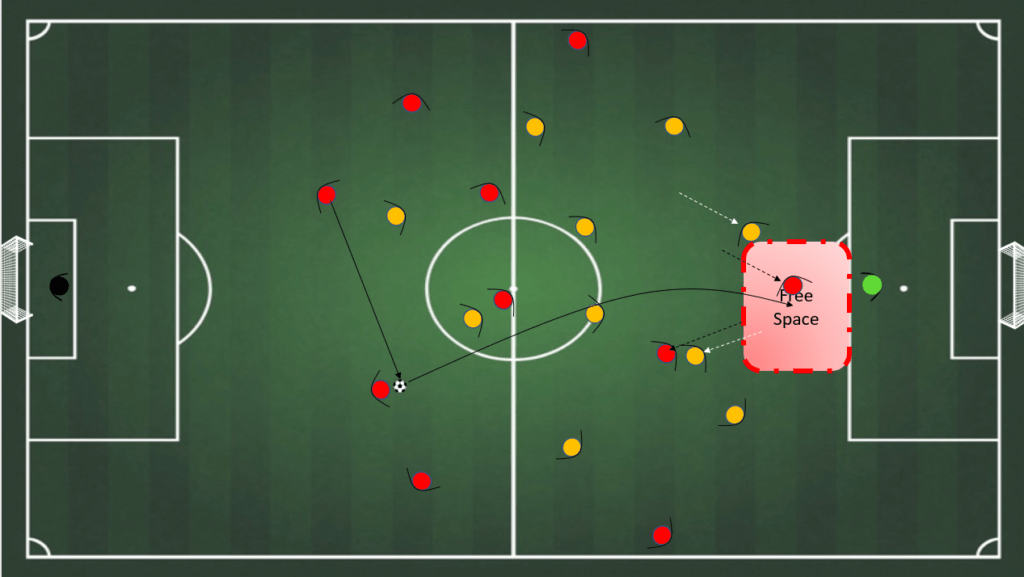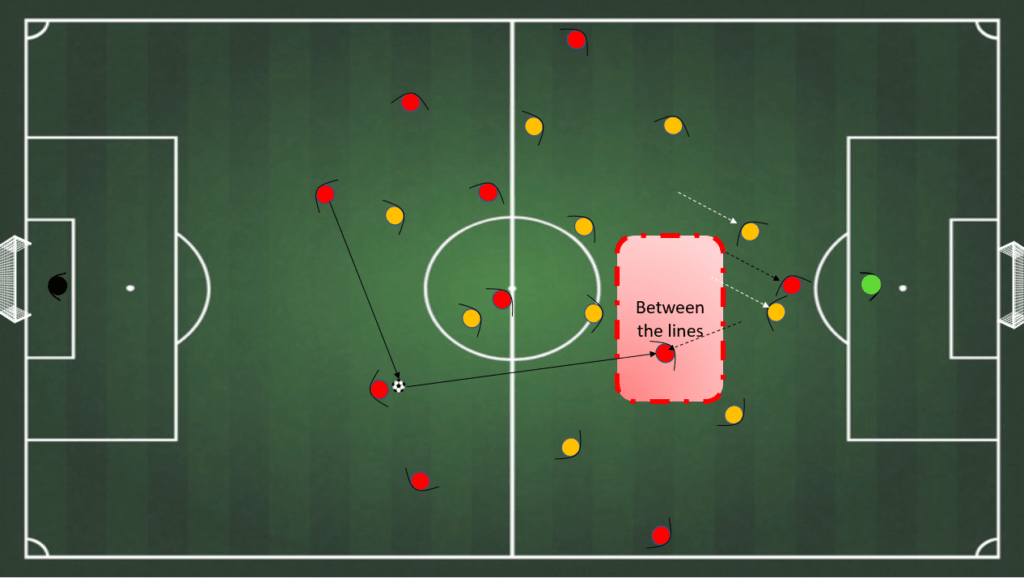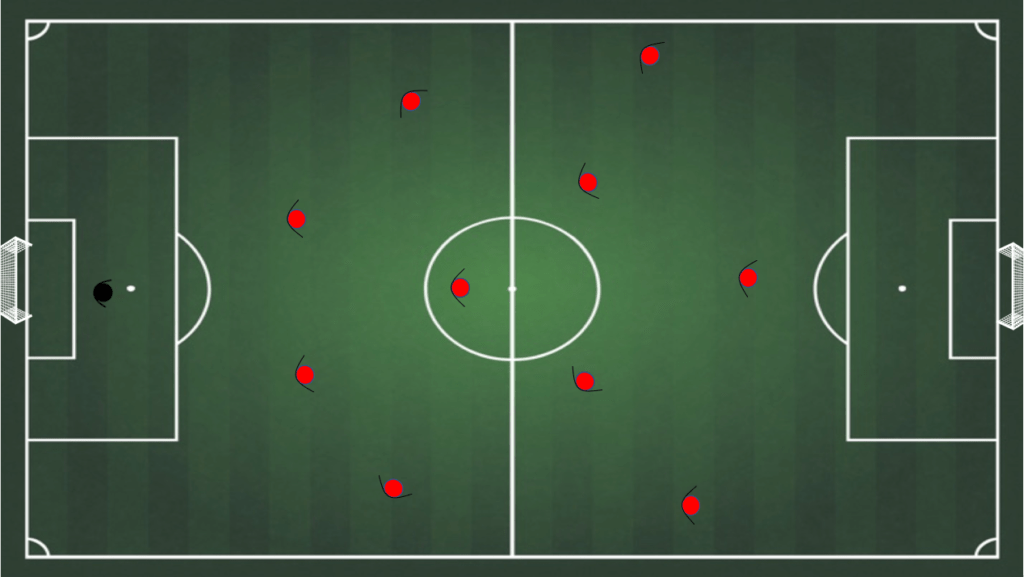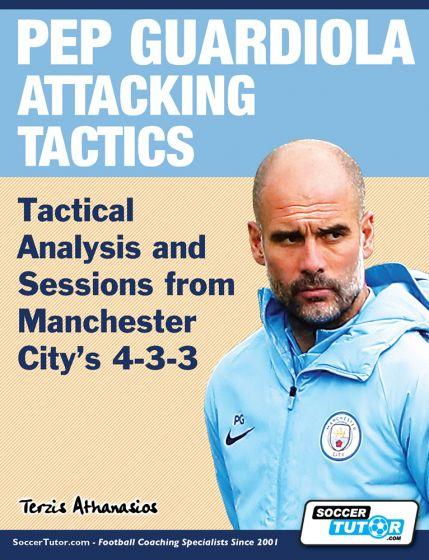Disclosure: Please note that some of the links below area affiliate links and at no additional cost to you I will earn a commission. Know that i only recommend products services and brands I have personally used and stand behind. When you use one of my affiliate links, the company compensates me, which helps me run this blog and keep my in -depth content free of change for readers (like you). Read our disclosure for more info.
Table of Contents
Football is a captivating blend of athleticism and strategy and football tactics is what makes it so challenging. At its core, it’s a strategic dance orchestrated by a team’s tactical formation. Tactics and formation are like an architectural blueprint, carefully arranging players on the field to define their roles and positions.
Think of it as a puzzle where each player is a unique piece that fits into the larger picture. Defenders create a solid foundation, midfielders control the rhythm, and forwards drive the attack. The formation sets the team’s style – whether they play possession football or opt for lightning-fast counterattacks.
But football tactics aren’t rigid; it adapts as the match unfolds. Coaches adjust them to counter the opponent’s moves or seize opportunities. Formation is a dynamic element that adds excitement, making each match a strategic showdown.
In essence, football tactics and formations creates a playbook that guides a team’s strategy, defining how they play and respond. Football is more than just skill; it’s a symphony of tactics and teamwork that keeps fans on the edge of their seats.
Elevate Your Coaching Game with FootballCoach365 Premium!
- 30-Minute Online Session with Our Expert Coach
- “Ask Me Anything” Option
- Premium Exclusive Content
- Complimentary Copy of “How to Train Positional Play” for Free
Upgrade your coaching skills with FootballCoach365 Premium! Get expert insights, video tutorials, tactical playbooks, training sessions, and more. Elevate your game – subscribe today.

Upgrade your coaching skills with FootballCoach365 Premium! Get expert insights, video tutorials, tactical playbooks, training sessions, and more. Elevate your game – subscribe today.
Elevate Your Coaching Game with FootballCoach365 Premium Subscription!
- 30-Minute Online Session with Our Expert Coach
- “Ask Me Anything” Option
- Premium Exclusive Content
- Complimentary Copy of “How to Train Positional Play” for Free
The Importance of Football Tactics and Formations
Football tactics are the blueprint of football strategy, shaping player interactions, defense, attack, and transitions. A well-chosen formation exploits opponents’ weaknesses while maximizing team strengths. Coaches analyze data and observe players to select the ideal formation.
These formations are more than Xs and Os; they’re the core behind every move on the pitch. They define a team’s approach, turning strengths into winning strategies. Coaches study players’ attributes, crafting formations that capitalize on their abilities.
Selecting a formation is critical to crafting a symphony, coordinating players’ skills into a cohesive performance. It’s a strategic dance, balancing offense and defense, aggression and control. The chosen formation becomes the team’s identity, guiding their style and decisions.
In the dynamic world of football, football tactics elevate the game from physical prowess to intellectual prowess. They are the strategy that turns a match into a masterful contest, where each formation is a calculated move, and every player is a strategic piece. As the players take their positions, the importance of tactical formations is vividly displayed—a fusion of strategy, skill, and teamwork that elevates football to an art form.
Key Factors in Choosing Formations
Selecting the right formation is a meticulous process that hinges on several essential factors:
- Team Strengths: Coaches assess their team’s unique strengths, such as midfield prowess or defensive solidity, to align the formation with these capabilities.
- Opponent Analysis: Thoroughly studying the opponent helps coaches identify weaknesses that the chosen formation can exploit, creating a tactical advantage.
- Playing Style: The formation must harmonize with the team’s playing style, whether it’s possession-based control or dynamic counter-attacks.
- Match Context: The significance of the match, be it a crucial final or a routine fixture, guides the decision towards a more defensive or attacking setup.
- Flexibility and Adaptability: A formation’s success lies in its adaptability, allowing the team to shift gears when facing different opponents or changing game situations.
- Player Understanding: Clear communication and player comprehension of roles within the formation are vital, ensuring seamless execution on the field.
Choosing a formation is an intricate blend of strategy, analysis, and effective communication, with each factor shaping the team’s tactical approach.
Exploring Different Tactical Formations
The Classic 4-4-2 Formation: A balanced Approach
The 4-4-2 formation is a classic setup with four defenders, four midfielders, and two forwards. It strikes a balance between defense and attack, offering width in midfield and options upfront.
Defensive Resilience: The four defenders create a solid backline, making it hard for opponents to exploit the flanks. Central midfielders provide support, forming a compact defensive shape. In many occasions the 4-4-2 formation is characterize as a “defensive football” and one of the main reasons for that is the huge success of Diego Simeone with Atletico Madrid and his football coaching philosophy used to win trophies.
Quick Transition to Attack: With two strikers, the 4-4-2 enables swift transitions from defense to attack. Midfielders link defense and forwards, catching opponents off guard.
Historical Success: England’s 1966 World Cup victory showcased the 4-4-2’s strengths. Geoff Hurst and Roger Hunt’s partnership led to crucial goals, highlighting its potential.
Modern Variations: Adaptations like the “flat 4-4-2” and “midfield diamond 4-4-2” offer flexibility while retaining the formation’s core principles.


The biggest advantage of the formation against any structure with a back 4, is the challenges that the two center backs of the opponents will have to face. The two forwards creates 1 v 1 situations with the two center forwards which allows for a number of movements to be done to create space or to receive a pass between the lines.
That requires a very good socio-affective superiority from the two forwards. They need good communication and very coordinate opposite movements to challenge the two forwards and force them to take the wrong decision.




Tactical Analysis and Sessions from Atlético Madrid’s 4-4-2
- How the Centre Backs Defend the Forwards’ Movements
- Rear Block’s Positioning and Movements to Control Wide Areas
- Pressing High Up the Pitch (from the Goalkeeper)
- Positioning of the Forwards to Prepare for Counter Attacks
- Counter-Pressing After Losing Possession During Combination Play
The 4-3-3 Formation: The Total Football era
The 4-3-3 formation is a dynamic and attacking setup that has left an indelible mark on modern football. The great Rinus Michels and his student Johan Cruyff were the first who introduce the use of 4 3 3 formation, through Total Football, as a means to play beautiful football. Comprising four defenders, three midfielders (one defensive midfielder and two attacking), and three forwards, its high-intensity pressing and quick transitions make it a force to be reckoned with.

One of the biggest advantages of the 4 3 3 formation is the creation of triangles and rhombus that helps the team in possession to maintain the ball possession. For that reason many teams who teams who prefers to implement a Positional Play style and ball oriented football tactics, use the specific football structure.

The Positional Play of Guardiola
Pep Guardiola’s Barcelona, Bayern Munich and Manchester City showcased the epitome of the 4-3-3 formation’s dominance. With players like Lionel Messi, Xavi Hernandez, Andres Iniesta and now Rodri and Kevin De Bruyne. Guardiola’s 4-3-3 system achieved unparalleled success. Quick passes, positional exchanges, rotations and a fluid movement of the ball by almost all the football players, allowed his teams to control the game and create scoring chances at will.
Forward Trio
The three forwards, often a central striker flanked by wingers, stretch and challenge defenses. Their synergy, off-the-ball runs, and positional rotations create spaces and goal-scoring opportunities. This attacking trio overwhelms defenses and excels at exploiting gaps behind the defensive line.
Modern Implementations
The 4-3-3 formation’s influence endures. Many top clubs and national teams have embraced variations, tailoring it to their style. The Netherlands’ 2010 World Cup campaign and Liverpool’s 2019 – 2020 Premier League triumph under Jurgen Klopp showcase its lasting impact.
PEP GUARDIOLA ATTACKING TACTICS – TACTICAL ANALYSIS AND SESSIONS FROM MANCHESTER CITY’S 4-3-3

Attacking Tactics from Manchester City’s 4-3-3
- Overcoming the Pressing of the Opposing Forwards
- Positioning and Rotations with Inverted Full Backs
- Creating and Exploiting Overloads in Wide Areas
- Attacking Options when the Overload Out Wide is Blocked
- Moving the Ball Wide and Receiving in Behind the Full Back (or Create Space for Inside Pass)
- Combination Play Out Wide when the Overload is Blocked
- Stretching the Opposition’s Defence and Switching Play
- Attacking Options when the Attacking Midfielder Receives Between the Lines
- Exploiting Space Created when the Opposing Centre Back Pushes Out to Press the Ball
- Attacking Through the Centre with the Forward Dropping Back to Receive
- Switching Play to the Weak Side when the Overload is Blocked Against the 4-3-3
- Attacking Against a Back 5
The 3-4-3 Formation: A Dynamic Attacking Symphony

The 3-4-3 formation is a thrilling spectacle in football tactics, featuring three defenders, four midfielders, and three forwards. This setup is a masterpiece of aggression, designed to overwhelm opponents and create a dynamic attacking force. Let’s explore the essence of playing with a back three and three forwards and its impact.
- Core Components: The heart of the 3-4-3 formation lies in its structure. Three defenders form the base, flanked by versatile players who contribute to both defense and attack.
- Midfield Mastery: A quartet in the midfield controls the game’s rhythm. Two central midfielders orchestrate play, while wide midfielders provide width and destabilize defenses.
- The Attacking Triad: The formation’s essence shines through its attacking trio. A central striker and two wide forwards collaborate to exploit gaps and breach defenses.
- Tactical Versatility: Adaptability defines the 3-4-3 formation. It shifts seamlessly from attack to defense, enabling quick transitions and counter-attacks.
Chelsea’s Triumph
Antonio Conte’s Chelsea epitomized the 3-4-3 formation’s potential during their 2016-2017 Premier League victory. Dynamic transitions, pressing, and clinical finishing characterized their play.
The Solid 5-3-2 Formation

The 5-3-2 formation is a defensive powerhouse with five defenders and three midfielders. It’s built to withstand pressure and frustrate opponents. Italy’s triumph in the 2006 World Cup is a prime example of its defensive strength. Italy’s disciplined defense conceded only two goals throughout the tournament, showcasing the formation’s effectiveness.
The 5-3-2/3-5-2 is also the formation and the football tactics used by coaches to secure great success with teams who in many occasions lack of the natural collective talent to dominate through ball possession. Bright examples are Antonio Konte with Inter, Massimiliano Allegri with Juventus and Gian Piero Gasperini with Atalanta.
Formation Structure and Roles
- Defenders (5): Three center-backs form a solid wall, while two wing-backs offer defensive support and contribute to attacks.
- Midfielders (3): A midfield trio controls the center, breaking opponents’ rhythm and supporting both defense and counterattacks.
Key Characteristics and Strategies
- Defense Focus: The 5-3-2 excels in defense, making it hard for opponents to penetrate the backline.
- Counterattacking: Despite its defensive nature, the formation maintains counterattacking potential through wing-backs.
- Midfield Control: The midfield trio dictates the game’s pace, intercepting passes and disrupting opponents.
Historical Success: Italy’s 2006 World Cup Win
Italy’s 5-3-2 mastery in the 2006 World Cup showcased its defensive prowess, conceding just two goals. Italy’s disciplined approach, especially in the final against France, secured their victory.
COACHING 3-5-2 TACTICS – 125 TACTICAL SOLUTIONS AND PRACTICES

Learn to “Coach The 3-5-2” with 125 Tactical Solutions and Practices in All Phases and Against Different Formations
- Tactical Strengths and Weaknesses of the 3-5-2 Formation
- 3-5-2 Tactics Against Different Formations (4-4-2, 4-2-3-1, 4-3-3, 4-3-1-2, 3-5-2 and 3-4-3)
- Overcoming the First Line of Pressing (Build-up Play from the Back)
- Moving the Ball in Between the Opposition’s Midfield and Defensive Lines
- Playing in Behind the Opposition’s Defensive Line
- Defensive Organisation and Pressing
- Organisation of the Defensive Line
- 41 Practices and Variations to Apply Tactical Solutions with the 3-5-2
Adapting Formations During the Match
Football is a dynamic game where coaches must adjust formations on the fly. This flexibility can exploit opportunities and neutralize threats, impacting the outcome. For example, a football team might switch to a more defensive formation to protect a lead. Adapting formations requires understanding team strengths, spotting opponent weaknesses, and making calculated changes that can shift the game’s momentum.
Seizing Opportunities
Adapting formations lets teams seize opportunities. If an opponent’s defense is vulnerable, shifting to an attacking formation can exploit that weakness. This might involve deploying an extra attacker or creating overloads in key areas.
Nullifying Threats
Formations can also nullify threats. If an opponent’s attackers are finding gaps, adjusting to a more compact formation can crowd those areas and limit their impact. This can counter specific attacking strategies and defensive vulnerabilities.
Balancing Risk and Reward
Formations should balance risk and reward. An attacking setup may increase scoring chances but leave the defense exposed. A defensive formation can provide stability at the back but limit offensive options.
Real-World Example
In the 2018 FIFA World Cup, Belgium shifted to a defensive formation to protect their lead against Brazil. This strategic change secured their victory by stifling Brazil’s comeback attempts.
The Mental Edge
Formation adaptation is also psychological. It shows coaching control and boosts player morale. Bold changes can inject determination into the team, influencing their performance.
Transition Play and Tactical Flexibility
Seamless transitions between defense and attack are essential in football. Players must swiftly shift focus and positions as possession changes. This quick changeover catches opponents off guard and opens up goal-scoring opportunities.
Adapting on the Fly:
Transition play demands soccer tactic flexibility. Teams must switch formations seamlessly, adapting to evolving game situations. This adaptability allows teams to surprise opponents and gain an edge.
Training for Success:
Training focuses on rapid transitions. Drills simulate possession changes, encouraging quick reactions. Communication and coordination are emphasized, ensuring players know when to advance or retreat.
Impact on Scoring:
Well-executed transitions create scoring chances. Exploiting opponent disarray can lead to one-on-one situations or numerical advantages in attack.
In essence, mastering transition play and tactical flexibility is crucial in modern football. Players who adapt quickly, communicate well, and seize transition moments can turn the game in their favor.
Defending Against Different Formations
Effectively defending against a variety of formations is a crucial skill in football. Coaches and defenders collaborate to counter opponents’ tactical setups. Here’s a glimpse into the art of defending against different formations:
Analyzing the Opponent
Understanding the opponent’s formation is key. Coaches study match footage and data to identify strengths and weaknesses.
Tailoring Defensive Tactics
Defenders are assigned roles based on the opponent’s setup. This can involve zone defense to deny space or man-marking to track key players.
Pressing and Adapting
Pressing disrupts the opponent’s rhythm. Defenders coordinate to apply pressure, adjusting tactics as the match unfolds.
Case Study: Defending the 3-5-2
Against a 3-5-2 formation, defenders must handle central midfielders and wide wing-backs. Compactness and coordination are vital.
Training and Implementing Football Tactics
Effective implementation of a tactical formation hinges on rigorous training and player comprehension. Coaches use a multifaceted approach to ensure seamless integration:
- Clear Roles: Coaches communicate each player’s responsibilities within the formation, clarifying positioning, movement, and defensive duties.
- Repetition: Repetitive drills embed the formation’s mechanics in players’ muscle memory, enhancing their execution during matches.
- Real-Game Simulation: Training mimics match scenarios, honing quick decision-making and adaptability under pressure.
- Individual Skills: Players’ unique strengths are harmonized with the formation to optimize performance.
- Analytical Feedback: Video analysis identifies strengths and areas for improvement, fostering continual growth.
- Mental Cohesion: Coaches cultivate shared understanding, promoting unity and cohesive execution of the formation.
Through dedicated training and a holistic approach, teams can master tactical formations, enhancing their gameplay and strategic prowess.
The Role of Technology in Modern football tactics
Technology has become a game-changer in football tactics. Advanced analytics and video analysis tools provide coaches with data-driven insights to optimize formations and player positions.
- Data-Driven Insights: Advanced analytics offer heat maps and movement patterns, revealing strategic areas on the field for attack and defense.
- Passing Precision: Passing networks illustrate ball distribution, helping coaches position players for efficient ball circulation and scoring chances.
- Player Tracking: GPS and wearable sensors track players’ real-time movements, offering work rate data for refining formations.
- Opponent Analysis: Video analysis tools dissect opponents’ formations, enabling targeted game plans.
- Interactive Simulations: A football manager can use simulations to experiment with formations and visualize tactical scenarios.
- Real-Time Adaptation: Technology allows real-time bench analysis, aiding swift tactical adjustments during matches.
Future Trends in Football Formations
Football tactics and formations are evolving alongside the game itself, with teams embracing new strategies for a competitive edge. Here’s a glimpse into potential trends shaping the future of formations:
- Player-Centric Formations: Expect formations tailored to players’ unique strengths, optimizing attributes like speed, creativity, and skills for maximum impact.
- Hybrid Flexibility: Hybrid formations blending defensive and offensive elements could become commonplace, offering quick adaptability in different game situations.
- Data-Driven Strategies: Data analytics will continue to shape formations, helping teams exploit opponent weaknesses and make real-time adjustments.
- Countering Pressing: Formations designed to counter high-pressing opponents will emerge, focusing on controlled passing and ball retention.
- Versatile Roles: Players may assume multiple roles seamlessly, adding surprise and complexity to team tactics.
- Possession Mastery: Formations emphasizing possession control will persist, dictating game tempo and frustrating opponents.
- Set-Piece Specialization: Expect unique formations for set-piece situations, optimizing attacking and defensive strategies during corners, free kicks, and throw-ins.
Conclusion
Mastering football tactics is an ongoing journey marked by strategic insights and dynamic adaptability. It’s not just about diagrams on a whiteboard; it’s about harnessing a team’s strengths, exploiting opponents’ weaknesses, and orchestrating a symphony of movement on the field.
Football tactics and formations serve as the blueprint for success, but they are not static formulas. Meticulous planning, fueled by data analysis and opponent study, lays the groundwork. Yet, the fluidity of the game demands adaptability—knowing when to pivot, shift, and recalibrate to seize opportunities.
Above all, understanding the essence of football is paramount. It’s about anticipating the ebb and flow of the game, sensing the pulse of the players, and connecting with the crowd’s energy. Mastering formations isn’t just a tactical endeavor; it’s an art that embraces the beautiful unpredictability of the sport.
As football continues to evolve, so will its formations. New strategies will emerge, trends will shift, and the quest for excellence will persist. Mastering tactical formations isn’t an end point; it’s a perpetual pursuit, an ever-rewarding journey that enriches the sport’s tapestry.
Step onto the field, armed with knowledge, adaptability, and a passion for the beautiful game. The canvas of formations is yours to paint, and the symphony of gameplay awaits your unique composition.
FAQs
- Q1: Can one formation work for all matches?
A: No, the choice of formation depends on various factors, including the opponent’s style and the team’s strengths.
- Q2: Are defensive formations less exciting to watch?
A: Not necessarily. Well-executed defensive formations can lead to intense tactical battles.
- Q3: How do formations impact player development?
A: Formations can influence a player’s development by shaping their tactical understanding and positional play.
- Q4: Are there formations specific to certain leagues?
A: While certain leagues may favor certain formations, adaptability remains crucial for success.
- Q5: Where can I learn more about football formations?
A: For more insights, tips, and resources

